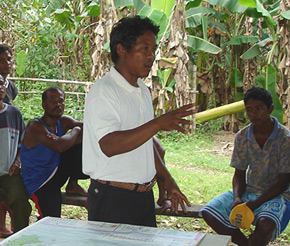
Đảo Coron là một quần đảo có nhiều rạn san hô, đầm nước lợ, rừng ngập mặn, rừng đá vôi và đa dạng sinh học phát triển mạnh mẽ. Có mười hồ trong khu vực được Calamian Tagbanwa coi là linh thiêng, gọi là Panyaan’s. Các hồ cũng được chính thức công nhận bởi nhà nước là lãnh thổ của tổ tiên bản địa. Trước áp lực phát triển ngày càng cao như khai thác mỏ và đánh bắt cá hiện đại, thật đáng nghi ngờ liệu sự công nhận này có bảo vệ thành công các giá trị văn hóa và sinh học của vùng đất Calamian Tagbanwa hay không.
Calamian Tagbanwa là cá những người có luật tục điều chỉnh việc đánh bắt cá, bao gồm cả việc xác định việc câu cá có được phép không. Các khu vực khác chỉ có thể được vào để sử dụng cho mục đích văn hóa khi có sự cho phép của các linh hồn. Đáng tiếc là dòng người di cư và thanh niên không tuân thủ các quy tắc phong tục đang đe dọa những khu vực linh thiêng này. Các phương pháp đánh bắt hiện đại hơn của họ kém bền vững hơn và các khu vực hạn chế được xác định theo truyền thống cũng như các quy định đánh bắt không được tôn trọng.. Calamian Tagbanwa tin rằng những hành vi vi phạm này đã khiến các linh hồn và con bạch tuộc thần thoại khổng lồ khó chịu., Kunlalybut, những người sống ở hồ.
những người có luật tục điều chỉnh việc đánh bắt cá, bao gồm cả việc xác định việc câu cá có được phép không. Các khu vực khác chỉ có thể được vào để sử dụng cho mục đích văn hóa khi có sự cho phép của các linh hồn. Đáng tiếc là dòng người di cư và thanh niên không tuân thủ các quy tắc phong tục đang đe dọa những khu vực linh thiêng này. Các phương pháp đánh bắt hiện đại hơn của họ kém bền vững hơn và các khu vực hạn chế được xác định theo truyền thống cũng như các quy định đánh bắt không được tôn trọng.. Calamian Tagbanwa tin rằng những hành vi vi phạm này đã khiến các linh hồn và con bạch tuộc thần thoại khổng lồ khó chịu., Kunlalybut, những người sống ở hồ.
May mắn là hầu hết người trẻ vẫn tôn trọng lời dạy của người lớn tuổi. Một giải pháp để đảm bảo duy trì các khu vực linh thiêng là đào tạo những người lớn tuổi và cộng đồng cách ứng phó với các mối đe dọa đối với vùng đất của họ. Một khía cạnh của điều đó là cho phép người lớn tuổi và cộng đồng tổ chức các cuộc họp để truyền đạt kiến thức truyền thống của họ cho thế hệ tiếp theo.. Bằng cách này, thế hệ trẻ tiếp tục gắn bó với những kiến thức thiêng liêng và luật tục..
Để biết thêm thông tin, hãy xem mô tả trang web trên nơi hoặc đọc nghiên cứu điển hình mà Arlene Sampang đã chuẩn bị cho cuốn sách: Thánh tự nhiên Sites, bảo tồn thiên nhiên & văn hóa, chương 24.
By: Rianne doller






